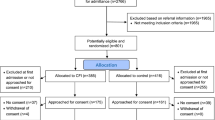Abstract
This paper focuses on the impact that culture has upon standardized or structured interviews. It briefly reviews how these interviews evolved from a primary research function, what they can teach us about clinical work, and the multiple ways that culture influences these supposedly objective instruments and the diagnoses which follow from their use. Although the use of structured interviews and standardized diagnostic criteria has been a major advance for the field in terms of reliability, care needs to be exercised when evaluating individuals from disparate cultural backgrounds.
Similar content being viewed by others
References
Abbey, S. A., & Garfinkel, P. E. (1991). Neurasthenia and chronic fatigue syndrome: The role of culture in the making of a diagnosis.American Journal of Psychiatry, 148, 1638–1646.
Aderibigbe, Y. A., & Pandurangi, A. K. (1995). The neglect of culture in psychiatric nosology: The case of culture bound syndromes.International Journal of Social Psychiatry, 41, 235–241.
Adebimpe, V. R., & Cohen, E. (1989). Schizophrenia and affective disorder in black and white patients: A methodologic note.Journal of the National Medical Association, 81, 761–765.
Cooper, J. E., Kendell, R. E., Gurland, B. J., Sharpe, L., Copeland, J. R. M., & Simon, R. (1972).Psychiatric diagnosis in New York and London. London: Oxford University Press.
Cottler, L. B., Robins, L. N., Grant, B. F., Towle, L. H., Wittchen, H.-U., Sartonus, N., & Participants in the Multicentre WHO/ADAMHA Field Trials (1991). The CIDI-core substance abuse and dependence questions: Cross-cultural and nosological issues.British Journal of Psychiatry, 159, 653–658.
DiNardo, P. A., & Barlow, D. H. J. (1988).Anxiety Disorders Interview Schedule-Revised (ADISR). Albany: State University of New York, Phobia and Anxiety Disorders Clinic.
Endicott, J., & Spitzer, R. L. (1979). A diagnostic interview: The Schedule for Affective Disorders and Schizophrenia.Archives of General Psychiatry, 35, 837–844.
Fabrega, H. (1994). International systems of diagnosis in psychiatry.Journal of Nervous Mental Disease, 182, 256–259.
Friedman, S., & Paradis, C. (1991). African-American patients with panic disorder and agoraphobia.Journal of Anxiety Disorders, 5, 35–41.
Kirmayer, L. J. (1991). The place of culture in psychiatric nosology: Taijin kyofusho and DSM-III-R.Journal of Nervous and Mental Disease, 179, 19–28.
Liebowitz, M. R., y Salmán, E., Jusino, C. M., Garfinkel, R., Street, L., Cárdenas, D. L., Silvestre, J., Fyer, A. J., Carrasco, J. L., Davies, S., Guarnaccia, P., & Klein, D. P. (1994). Ataque de nervios and panic disorder.American Journal of Psychiatry, 151, 871–875.
Lin, K. M., Lau, J. K., Yamamoto, J., Zheng, Y. P., Kim, H. S., Cho, K. H., & Nakasaki, G. (1992). Hwa-byung: A community study of Korean Americans.Journal of Nervous and Mental Disorders, 180, 386–391.
Mezzich, J. E., Kleinman, A., Fabrega, H., & Parron, D. (1995).Culture and psychiatric diagnosis. Washington, DC: American Psychiatric Press.
Nikelly, A. G. (1992). Can DSM-III-R be used in the diagnosis of non-western patients?International Journal of Mental Health, 21, 3–22.
Robins, L. N., Helzer, J. E., Croughan, J., & Ratcliff, K. S. (1981). National Institute of Mental Health Diagnostic Interview Schedule: Its history, characteristics, and validity.Archives of General Psychiatry, 38, 381–8389.
Rogler, L. H. (1993). Culturally sensitizing psychiatric diagnosis: A framework for research.Journal of Nervous and Mental Disease, 181, 401–408.
Ruiz, P. (1995). Assessing, diagnosing and treating culturally diverse individuals: A Hispanic perspective.Psychiatric Quarterly, 66, 329–341.
Spitzer, R. L., Endicott J., & Robins, E. (1978). Research diagnostic criteria: Rationale and reliability.Archives of General Psychiatry, 35, 773–782.
Spitzer, R. L., Williams, J. B. W. Gibbon, M., & First, M. B. (1990).Structured clinical interview for DSM-III-R—Patient Edition (SCII)-P). Washington, DC: American Psychiatric Press.
Spitzer, R. L., Williams, J. B. W., Gibbon, M., & First, M. B. (1992). The structured clinical interview for DSM-III-R (SCID). I. History, rationale, and description.Archives of General Psychiatry, 49, 624–629.
Twemlow, S. W. (1995). DSM-IV from a cross-cultural perspective.Psychiatric Annals, 25, 46–52.
Weiss, M. G., Doongaji, D. R., Siddahrth, S., Wypij, D., Pathare, S., Bhatawdekar, M., Bhave, A., Sheth, A., & Fernandes, R. (1992). The explanatory model interview catalogue (EMIC): contribution to cross-cultural research methods from a study of leprosy and mental health.British Journal of Psychiatry, 160, 819–830.
Weiss, M. G., Raguroom, R., & Channabasavanna, S. M. (1995). Cultural dimensions of psychiatric diagnosis.British Journal of Psychiatry, 166, 353–359.
Williams, J. B. W., Gibbon, M., First, M. B., Spitzer, R. L., Davies, M., Borus, J., Howes, M. J., Kane, J., Pope, H. G., Rounsaville, B., & Wittchen, H.-W. (1992). The structured clinical interview for DSM-III-R (SCID). II. Multisite test-retest reliability.Archives of General Psychiatry, 49, 630–636.
Wing, J. K., Cooper, J. E., & Sartorius, N. (1974).Measurement and classification of psychiatric symptoms. New York: Cambridge University Press.
Wittchen, H.-U., Robins, L. N., Cottler, L. B., Sartorius, N., Burke, J. D., Regier, D., & Participants in the Multicentre WHO/ADAMHA Field Trials (1991). Cross-cultural feasibility, reliability, and sources of variance of the Composite International Diagnostic Interview (CIDI).British Journal of Psychiatry, 159, 645–653.
World Health Organization (1994).The Composite International Diagnostic Interview (CIDI). Washington, DC: American Psychiatric Press.
Zimmerman, M. (1994). Diagnosing personality disorders: A review of issues and research methods.Archives of General Psychiatry, 51, 225–245.
Author information
Authors and Affiliations
Rights and permissions
About this article
Cite this article
Lesser, I.M. Cultural considerations using the structured clinical interview for DSM-III for mood and anxiety disorders assessment. J Psychopathol Behav Assess 19, 149–160 (1997). https://doi.org/10.1007/BF02229040
Accepted:
Issue Date:
DOI: https://doi.org/10.1007/BF02229040




